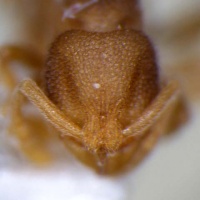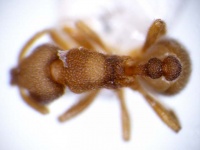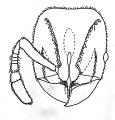Formosimyrma
| Formosimyrma | |
|---|---|

| |
| Formosimyrma lanyuensis | |
| Scientific classification | |
| Kingdom: | Animalia |
| Phylum: | Arthropoda |
| Class: | Insecta |
| Order: | Hymenoptera |
| Family: | Formicidae |
| Subfamily: | Myrmicinae |
| Tribe: | Crematogastrini |
| Genus: | Formosimyrma Terayama, 2009 |
| Type species | |
| Formosimyrma lanyuensis | |
| Diversity | |
| 1 species (Species Checklist, Species by Country) | |
The holotype worker of this monotypic genus was collected in an evergreen forest in Taiwan.
| At a Glance | • Monotypic |
Identification
Terayama (2009) - Formosimyrma is a member of the Solenopsidini tribe in the Subfamily Myrmicinae. Within the genera of tribe Solenopsidini, this genus most resembles the genus Mayriella, distributed from Nepal through Southeast Asia into Papua New Guinea and Australia to New Zealand. However, it is distinguished from the latter by the median portion of clypeus with a thin and high longitudinal wall (anterior margin of clypeus armed with a pair of sharp teeth just above the mandibles in Mayriella), 8-segmented antennae (10-segmented in Mayriella), and oval eyes (eyes elongate and lower section narrows into a point in Mayriella)
| See images of species within this genus |
Keys including this Genus
Distribution
Distribution and Richness based on AntMaps
Species by Region
Number of species within biogeographic regions, along with the total number of species for each region.
| Afrotropical Region | Australasian Region | Indo-Australian Region | Malagasy Region | Nearctic Region | Neotropical Region | Oriental Region | Palaearctic Region | |
|---|---|---|---|---|---|---|---|---|
| Species | 0 | 0 | 0 | 0 | 0 | 0 | 1 | 0 |
| Total Species | 2841 | 1736 | 3045 | 932 | 835 | 4379 | 1741 | 2862 |
Biology
Castes
Worker
Nomenclature
The following information is derived from Barry Bolton's Online Catalogue of the Ants of the World.
- FORMOSIMYRMA [Myrmicinae: Solenopsidini]
- Formosimyrma Terayama, 2009: 158. Type-species: Formosimyrma lanyuensis, by original designation.
Unless otherwise noted the text for the remainder of this section is reported from the publication that includes the original description.
Description
Worker
Diagnosis of worker. Monomorphic terrestrial myrmicine ants with the following combination of characters.
- Mandible broad triangle, with 7 teeth.
- Median portion of clypeus with a thin and high longitudinal wall; the wall well produced anteriorly in full face view.
- Frontal lobes narrow, connected each other, and produced and covered to the level of anterior margin of clypeus.
- Frontal carinae and antennal scrobes developed.
- Eye small and oval, positioned in front of the midlength of the sides of the head.
- Antenna 8-segmented; scape short, apical 2 segments froming a distinct club.
- Mesosoma short and stout; promesonotal dorsum convex in profile.
- Metanotal groove present.
- Propodeum with a pair of acute teeth.
- Petiole with long peduncle and reversed U-shape node.
- Postpetiole higher than long.
- Middle and hind tibiae without tibial spur.
Etymology
Formosi, old name of Taiwan, 'Formosa' + myrma, Gr., ant.
References
- Terayama, M. 2009. A synopsis of the family Formicidae of Taiwan. Research Bulletin of Kanto Gakuen University 17: 81-266. [[Media:Terayama 2009.pdf| *Blaimer, B.B., Ward, P.S., Schultz, T.R., Fisher, B.L., Brady, S.G. 2018. Paleotropical diversification dominates the evolution of the hyperdiverse ant tribe Crematogastrini (Hymenoptera: Formicidae). Insect Systematics and Diversity 2(5): 3; 1-14 (doi:10.1093/isd/ixy013).
- Cantone S. 2018. Winged Ants, The queen. Dichotomous key to genera of winged female ants in the World. The Wings of Ants: morphological and systematic relationships (self-published).
'PDF]]




